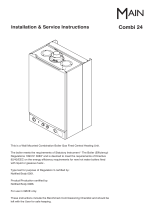
1. THINGS YOU SHOULD KNOW ...................................................1
1.1 GAS APPLIANCES ..................................................................1
1.2 ELECTRICAL SUPPLY ............................................................1
1.3 GUARANTEE REGISTRATION CARD ...................................1
1.4 APPLIANCE COMMISSIONING CHECKLIST (UK only) ........1
1.5 HOW DOES IT WORK? ..........................................................1
1.6 DIMENSIONS .......................................................................... 1
1.7 CLEARANCES REQUIRED ....................................................1
1.8 FROST PROTECTION SYSTEM ............................................1
1.9 APPLIANCE STATUS INDICATORS ....................................... 1
1.10 GAS APPLIANCES ..................................................................3
1.11 MODES OF OPERATION .......................................................4
1.12 SETTING THE TIME AND DAY ............................................... 4
1.13 CHANGING THE HEATING PATTERN ................................... 4
1.14 ADVANCE FUNCTION ............................................................4
1.15 MODE OF OPERATION ..........................................................4
1.16 RESET HEATING PROGRAM TO DEFAULT VALUES ...........4
2. GETTING STARTED ....................................................................5
2.1 BEFORE SWITCHING ON ...................................................... 5
2.2 APPLIANCE CONTROLS ......................................................5
2.3 LIGHTING THE BOILER .........................................................5
2.4 ADJUSTING THE HEATING TEMPERATURE .......................5
2.5 ADJUSTING THE HOT WATER TEMPERATURE .................. 5
2.6 EXPLANATION OF FEATURES ..............................................5
2.7 AUTOMATIC TEMPERATURE CONTROL .............................5
3. HOW TO.... ................................................................................... 5
3.1 HOW TO TOP-UP THE SYSTEM PRESSURE ......................5
3.2 HOW TO FILL THE CONDENSATE TRAP ..............................5
3.3 HOW TO RESET THE APPLIANCE ................................................5
3.4 HOW TO SHUT DOWN THE SYSTEM FOR SHORT PERIODS 6
3.5 HOW TO SHUT DOWN THE SYSTEM FOR LONG PERIODS ..6
3.6 HOW TO CARE FOR THE APPLIANCE .................................6
4. WHAT IF .......................................................................................6
4.1 WHAT IF I SUSPECT A GAS LEAK ........................................6
4.2 WHAT IF I HAVE FREQUENTLY TO TOP-UP THE SYSTEM ....6
4.3 WHAT IF THE APPLIANCE IS DUE ITS ANNUAL SERVICE ....6
4.4 WHAT IF I NEED TO CALL AN ENGINEER ............................6
INSTALLATION AND SERVICING INSTRUCTIONS ..................7
SECTION 1 - DESIGN PRINCIPLES AND OPERATING
SEQUENCE .....................................................................................8
1.1 PRINCIPLE COMPONENTS ...................................................8
1.2 MODE OF OPERATION (at rest) ............................................8
1.3 MODE OF OPERATION (Heating) ..........................................8
1.4 MODE OF OPERATION (Hot water) .......................................8
1.5 SAFETY DEVICES .................................................................. 8
SECTION 2 - TECHNICAL DATA ....................................................9
2.1 CENTRAL HEATING..............................................................9
2.2 DOMESTIC HOT WATER......................................................9
2.3 GAS PRESSURES ................................................................9
2.4 FAN SPEED (G20) ................................................................. 9
2.5 EXPANSION VESSEL ...........................................................9
2.6 DIMENSIONS .........................................................................9
2.7 CLEARANCES .......................................................................9
2.8 CONNECTIONS .....................................................................9
2.9 ELECTRICAL .........................................................................9
2.10 FLUE DETAILS (CONCENTRIC 60-100) .............................9
2.10A FLUE DETAILS (CONCENTRIC 80-125) .............................9
2.10B FLUE DETAILS (TWIN PIPES) .......................................9
2.11 EFFICIENCY .......................................................................... 9
2.12 EMISSIONS............................................................................9
2.13 PUMP ....................................................................................11
SECTION 3 - GENERAL REQUIREMENTS (UK) .........................12
3.1 RELATED DOCUMENTS ......................................................12
3.2 LOCATION OF APPLIANCE .................................................12
3.3 GAS SUPPLY ........................................................................12
3.4 FLUE SYSTEM ......................................................................12
3.5 AIR SUPPLY ..........................................................................12
3.6 WATER CIRCULATION .........................................................12
3.7 ELECTRICAL SUPPLY ..........................................................13
3.8 MOUNTING ON A COMBUSTIBLE SURFACE ..................... 13
3.9 TIMBER FRAMED BUILDINGS ............................................13
3.10 INHIBITORS ..........................................................................13
3.11 SHOWERS ............................................................................ 13
SECTION 3A - GENERAL REQUIREMENTS (EIRE) ....................13
3A.1 RELATED DOCUMENTS ...................................................... 13
3A.2 LOCATION OF APPLIANCE .................................................13
3A.3 GAS SUPPLY ........................................................................13
3A.4 FLUE SYSTEM ......................................................................13
3A.5 AIR SUPPLY ..........................................................................14
3A.6 WATER CIRCULATION .........................................................14
3A.7 ELECTRICAL SUPPLY ..........................................................14
3A.8 MOUNTING ON A COMBUSTIBLE SURFACE ..................... 14
3A.9 TIMBER FRAMED BUILDINGS ............................................14
3A.10 INHIBITORS ......................................................................... 14
3A.11 SHOWERS ...........................................................................14
3A.12 DECLARATION OF CONFORMITY ..................................... 14
SECTION 4 - INSTALLATION .......................................................15
4.1 DELIVERY .......................................................................... 15
4.2 CONTENTS ........................................................................... 15
4.3 UNPACKING .........................................................................15
4.4 PREPARATION FOR MOUNTING THE APPLIANCE ........... 15
4.5 FITTING THE FLUE ..............................................................15
4.6 CONNECTING THE GAS AND WATER ................................19
4.7 ELECTRICAL CONNECTIONS ............................................. 19
SECTION 5 - COMMISSIONING ...................................................20
5.1 GAS SUPPLY INSTALLATION ..............................................20
5.2 THE HEATING SYSTEM ....................................................... 20
5.3 INITIAL FILLING OF THE SYSTEM ......................................20
5.4 INITIAL FLUSHING OF THE SYSTEM .................................20
5.5 PRE-OPERATION CHECKS .................................................20
5.6 INITIAL LIGHTING .................................................................20
5.7 CHECKING GAS PRESSURE AND COMBUSTION ANALYSIS 20
5.8 FINAL FLUSHING OF THE HEATING SYSTEM ...................20
5.9 SETTING THE FLOW OUTLET TEMPERATURE ................20
5.10 SETTING THE SYSTEM DESIGN PRESSURE ...................20
5.11 REGULATING THE CENTRAL HEATING SYSTEM ............. 21
5.12 FINAL CHECKS .....................................................................21
5.13 INSTRUCTING THE USER ................................................... 21
SECTION 6 - SERVICING INSTRUCTIONS ..................................21
6.1 GENERAL ..............................................................................21
6.2 ROUTINE ANNUAL SERVICING ..........................................21
6.3 REPLACEMENT OF COMPONENTS ................................... 21
6.4 COMPONENT REMOVAL PROCEDURE .............................22
6.5 PUMP ASSEMBLY ...............................................................22
6.6 SAFETY VALVE ....................................................................22
6.7 LOWER AUTOMATIC AIR RELEASE VALVE .......................22
6.8 WATER PRESSURE SWITCH ............................................. 22
6.9 FLOW THERMISTOR ...........................................................22
6.10 RETURN THERMISTOR ....................................................... 22
6.11 PRINTED CIRCUIT BOARD ................................................23
6.12 GAS VALVE .......................................................................... 23
6.13 ELECTRODES .....................................................................23
6.14 FLUE FAN & MIXER .............................................................23
6.15 BURNER ...............................................................................23
6.16 MAIN HEAT EXCHANGER ....................................................24
6.17 AUTOMATIC BY-PASS & DHW NON-RETURN ....................24
6.18 EXPANSION VESSEL REMOVAL ........................................ 24
6.19 CONDENSE TRAP REMOVAL ..............................................24
6.20 FLUE COLLECTOR REMOVAL ...........................................25
SECTION 7 - CHECKS, ADJUSTMENTS AND FAULT FINDING
....26
7.1 CHECKING APPLIANCE OPERATION .................................26
7.2 APPLIANCE MODES OF OPERATION ................................26
7.3 CHECKING THE CO
2 AND ADJUSTING THE GAS VALVE . 26
7.4 COMBUSTION ANALYSIS TEST .......................................... 27
7.5 CHECKING THE EXPANSION VESSEL ............................... 27
7.6 EXTERNAL FAULTS .............................................................27
7.7 ELECTRICAL CHECKS .........................................................27
7.8 FAULT FINDING .................................................................... 28
7.9 COMPONENT VALUES & CHARACTERISTICS .................. 28
7.10 ADJUSTMENTS .................................................................... 28
SECTION 8 - WIRING DIAGRAMS ...............................................30
8.1 EXTERNAL WIRING .............................................................30
8.2 OTHER DEVICES .................................................................30
SECTION 9 - LPG INSTRUCTIONS .............................................. 32
9.1 RELATED DOCUMENTS ......................................................32
9.2 TECHNICAL DATA ................................................................32
9.3 CONVERTING THE APPLIANCE GAS TYPE .......................32
9.4 GAS SUPPLY ........................................................................32
9.5 GAS SUPPLY INSTALLATION ..............................................32
9.6 CHECKING THE CO
2 AND ADJUSTING THE GAS VALVE ....32
Commissioning checklist ........................................................... 34
Benchmark .............................................................................. 35-37
Vokèra Warranty Terms and Conditions ....................................39




















